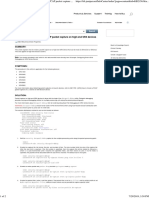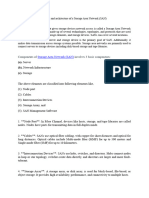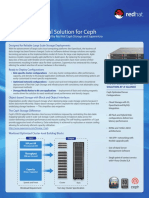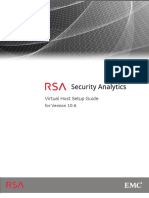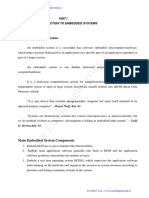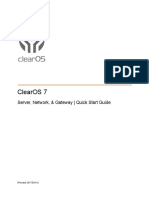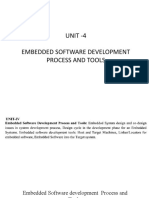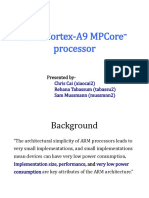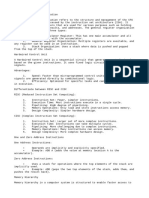Embedded Packet Capture Overview: Finding Feature Information
Embedded Packet Capture Overview: Finding Feature Information
Uploaded by
Manoj BCopyright:
Available Formats
Embedded Packet Capture Overview: Finding Feature Information
Embedded Packet Capture Overview: Finding Feature Information
Uploaded by
Manoj BOriginal Description:
Original Title
Copyright
Available Formats
Share this document
Did you find this document useful?
Is this content inappropriate?
Copyright:
Available Formats
Embedded Packet Capture Overview: Finding Feature Information
Embedded Packet Capture Overview: Finding Feature Information
Uploaded by
Manoj BCopyright:
Available Formats
Embedded Packet Capture Overview
Embedded Packet Capture (EPC) provides an embedded systems management facility that helps in tracing
and troubleshooting packets. This feature allows network administrators to capture data packets flowing
through, to, and from a Cisco device. The network administrator may define the capture buffer size and type
(circular, or linear), the maximum number of bytes of each packet to capture, and the direction of the traffic
flow - ingress or egress, or both. The packet capture rate can be throttled using further administrative controls.
For example, you can use the available options for filtering the packets to be captured using an Access Control
List; and, optionally, further defined by specifying a maximum packet capture rate or by specifying a sampling
interval.
• Finding Feature Information, on page 1
• Prerequisites for Embedded Packet Capture, on page 1
• Restrictions for Embedded Packet Capture, on page 2
• Information About Embedded Packet Capture, on page 2
• How to Implement Embedded Packet Capture, on page 3
• Configuration Examples for Embedded Packet Capture, on page 6
• Additional References, on page 9
• Feature Information for Embedded Packet Capture, on page 9
Finding Feature Information
Your software release may not support all the features documented in this module. For the latest caveats and
feature information, see Bug Search Tool and the release notes for your platform and software release. To
find information about the features documented in this module, and to see a list of the releases in which each
feature is supported, see the feature information table.
Use Cisco Feature Navigator to find information about platform support and Cisco software image support.
To access Cisco Feature Navigator, go to www.cisco.com/go/cfn. An account on Cisco.com is not required.
Prerequisites for Embedded Packet Capture
The Embedded Packet Capture (EPC) software subsystem consumes CPU and memory resources during its
operation. You must have adequate system resources for different types of operations. Some guidelines for
using the system resources are provided in the table below.
Embedded Packet Capture Overview
1
Embedded Packet Capture Overview
Restrictions for Embedded Packet Capture
Table 1: System Requirements for the EPC Subsystem
System Resources Requirements
Hardware CPU utilization requirements are platform dependent.
Memory The packet buffer is stored in DRAM. The size of the
packet buffer is user specified.
Diskspace Packets can be exported to external devices. No
intermediate storage on flash disk is required.
Restrictions for Embedded Packet Capture
• Embedded Packet Capture (EPC) captures multicast packets only on ingress and does not capture the
replicated packets on egress.
• From Cisco IOS XE Release 3.7S, Embedded Packet Capture is only supported on Advance Enterprise
Krypto (K9) images.
• From Cisco IOS XE Release 3.9S, Embedded Packet Capture is available on the following images:
• IP Base Images
• Special Services Images
• Advance Security Images
• Advance IP Services Images
• Advance Enterprise Images
Information About Embedded Packet Capture
Embedded Packet Capture Overview
Embedded Packet Capture (EPC) provides an embedded systems management facility that helps in tracing
and troubleshooting packets. This feature allows network administrators to capture data packets flowing
through, to, and from a Cisco device. The network administrator may define the capture buffer size and type
(circular, or linear), the maximum number of bytes of each packet to capture, and the direction of the traffic
flow - ingress or egress, or both. The packet capture rate can be throttled using further administrative controls.
For example, you can use the available options for filtering the packets to be captured using an Access Control
List; and, optionally, further defined by specifying a maximum packet capture rate or by specifying a sampling
interval.
Benefits of Embedded Packet Capture
• Ability to capture IPv4 and IPv6 packets in the device.
• Extensible infrastructure for enabling packet capture points. A capture point is a traffic transit point
where a packet is captured and associated with a buffer.
Embedded Packet Capture Overview
2
Embedded Packet Capture Overview
Packet Data Capture
• Facility to export the packet capture in packet capture file (PCAP) format suitable for analysis using any
external tool.
• Methods to decode data packets captured with varying degrees of detail.
Packet Data Capture
Packet data capture is the capture of data packets that are then stored in a buffer. You can define packet data
captures by providing unique names and parameters.
You can perform the following actions on the capture:
• Activate captures at any interface.
• Apply access control lists (ACLs) or class maps to capture points.
Note Network Based Application Recognition (NBAR) and MAC-style class map is
not supported.
• Destroy captures.
• Specify buffer storage parameters such as size and type. The size ranges from 1 MB to 100 MB. The
default buffer is linear; the other option for the buffer is circular.
• Specify any of the following limit options:
• duration - limit total duration of capture in seconds.
• every - limit capture to one in every nth packet.
• packet-len - limit the packet length to capture.
• packets - limit number of packets to capture.
• pps - limit number of packets per second to capture.
• Specify match criteria that includes information about the protocol, IP address or port address.
How to Implement Embedded Packet Capture
Managing Packet Data Capture
SUMMARY STEPS
1. enable
2. monitor capture capture-name access-list access-list-name
3. monitor capture capture-name limit duration seconds
4. monitor capture capture-name interface interface-name both
5. monitor capture capture-name buffer circular size bytes
Embedded Packet Capture Overview
3
Embedded Packet Capture Overview
Managing Packet Data Capture
6. monitor capture capture-name start
7. monitor capture capture-name export file-location/file-name
8. monitor capture capture-name stop
9. end
DETAILED STEPS
Command or Action Purpose
Step 1 enable Enables privileged EXEC mode.
Example: • Enter your password if prompted.
Device> enable
Step 2 monitor capture capture-name access-list Configures a monitor capture specifying an access list as
access-list-name the core filter for the packet capture.
Example:
Device# monitor capture mycap access-list v4acl
Step 3 monitor capture capture-name limit duration seconds Configures monitor capture limits.
Example:
Device# monitor capture mycap limit duration 1000
Step 4 monitor capture capture-name interface interface-name Configures monitor capture specifying an attachment point
both and the packet flow direction.
Example: Note • To change the traffic direction from both
Device# monitor capture mycap interface to in (ingress direction), enter the no
GigabitEthernet 0/0/1 both monitor capture capture-name interface
interface-name out command.
• To change the traffic direction from both
to out (egress direction), enter the no
monitor capture capture-name interface
interface-name in command.
Step 5 monitor capture capture-name buffer circular size Configures a buffer to capture packet data.
bytes
Example:
Device# monitor capture mycap buffer circular size
10
Step 6 monitor capture capture-name start Starts the capture of packet data at a traffic trace point into
a buffer.
Example:
Device# monitor capture mycap start
Step 7 monitor capture capture-name export Exports captured data for analysis.
file-location/file-name
Example:
Embedded Packet Capture Overview
4
Embedded Packet Capture Overview
Monitoring and Maintaining Captured Data
Command or Action Purpose
Device# monitor capture mycap export
tftp://10.1.88.9/mycap.pcap
Step 8 monitor capture capture-name stop Stops the capture of packet data at a traffic trace point.
Example:
Device# monitor capture mycap stop
Step 9 end Exits privileged EXEC mode.
Example:
Device# end
Monitoring and Maintaining Captured Data
Perform this task to monitor and maintain the packet data captured. Capture buffer details and capture point
details are displayed.
SUMMARY STEPS
1. enable
2. show monitor capture capture-buffer-name buffer dump
3. show monitor capture capture-buffer-name parameter
4. debug epc capture-point
5. debug epc provision
6. exit
DETAILED STEPS
Command or Action Purpose
Step 1 enable Enables privileged EXEC mode.
Example: • Enter your password if prompted.
Device> enable
Step 2 show monitor capture capture-buffer-name buffer (Optional) Displays a hexadecimal dump of captured packet
dump and its metadata.
Example:
Device# show monitor capture mycap buffer dump
Step 3 show monitor capture capture-buffer-name parameter (Optional) Displays a list of commands that were used to
specify the capture.
Example:
Device# show monitor capture mycap parameter
Step 4 debug epc capture-point (Optional) Enables packet capture point debugging.
Example:
Embedded Packet Capture Overview
5
Embedded Packet Capture Overview
Configuration Examples for Embedded Packet Capture
Command or Action Purpose
Device# debug epc capture-point
Step 5 debug epc provision (Optional) Enables packet capture provisioning debugging.
Example:
Device# debug epc provision
Step 6 exit Exits privileged EXEC mode.
Example:
Device# exit
Configuration Examples for Embedded Packet Capture
Example: Managing Packet Data Capture
The following example shows how to manage packet data capture:
Device> enable
Device# monitor capture mycap access-list v4acl
Device# monitor capture mycap limit duration 1000
Device# monitor capture mycap interface GigabitEthernet 0/0/1 both
Device# monitor capture mycap buffer circular size 10
Device# monitor capture mycap start
Device# monitor capture mycap export tftp://10.1.88.9/mycap.pcap
Device# monitor capture mycap stop
Device# end
Example: Monitoring and Maintaining Captured Data
The following example shows how to dump packets in ASCII format:
Device# show monitor capture mycap buffer dump
0
0000: 01005E00 00020000 0C07AC1D 080045C0 ..^...........E.
0010: 00300000 00000111 CFDC091D 0002E000 .0..............
0020: 000207C1 07C1001C 802A0000 10030AFA .........*......
0030: 1D006369 73636F00 0000091D 0001 ..example.......
1
0000: 01005E00 0002001B 2BF69280 080046C0 ..^.....+.....F.
0010: 00200000 00000102 44170000 0000E000 . ......D.......
0020: 00019404 00001700 E8FF0000 0000 ..............
2
0000: 01005E00 0002001B 2BF68680 080045C0 ..^.....+.....E.
0010: 00300000 00000111 CFDB091D 0003E000 .0..............
0020: 000207C1 07C1001C 88B50000 08030A6E ...............n
0030: 1D006369 73636F00 0000091D 0001 ..example.......
Embedded Packet Capture Overview
6
Embedded Packet Capture Overview
Example: Monitoring and Maintaining Captured Data
3
0000: 01005E00 000A001C 0F2EDC00 080045C0 ..^...........E.
0010: 003C0000 00000258 CE7F091D 0004E000 .<.....X........
0020: 000A0205 F3000000 00000000 00000000 ................
0030: 00000000 00D10001 000C0100 01000000 ................
0040: 000F0004 00080501 0300 ................
The following example shows how to display the list of commands used to configure the capture
named mycap:
Device# show monitor capture mycap parameter
monitor capture mycap interface GigabitEthernet 1/0/1 both
monitor capture mycap match any
monitor capture mycap buffer size 10
monitor capture mycap limit pps 1000
The following example shows how to debug the capture point:
Device# debug epc capture-point
EPC capture point operations debugging is on
Device# monitor capture mycap start
*Jun 4 14:17:15.463: EPC CP: Starting the capture cap1
*Jun 4 14:17:15.463: EPC CP: (brief=3, detailed=4, dump=5) = 0
*Jun 4 14:17:15.463: EPC CP: final check before activation
*Jun 4 14:17:15.463: EPC CP: setting up c3pl infra
*Jun 4 14:17:15.463: EPC CP: Setup c3pl acl-class-policy
*Jun 4 14:17:15.463: EPC CP: Creating a class
*Jun 4 14:17:15.464: EPC CP: Creating a class : Successful
*Jun 4 14:17:15.464: EPC CP: class-map Created
*Jun 4 14:17:15.464: EPC CP: creating policy-name epc_policy_cap1
*Jun 4 14:17:15.464: EPC CP: Creating Policy epc_policy_cap1 of type 49 and client type
21
*Jun 4 14:17:15.464: EPC CP: Storing a Policy
*Jun 4 14:17:15.464: EPC CP: calling ppm_store_policy with epc_policy
*Jun 4 14:17:15.464: EPC CP: Creating Policy : Successful
*Jun 4 14:17:15.464: EPC CP: policy-map created
*Jun 4 14:17:15.464: EPC CP: creating filter for ANY
*Jun 4 14:17:15.464: EPC CP: Adding acl to class : Successful
*Jun 4 14:17:15.464: EPC CP: Setup c3pl class to policy
*Jun 4 14:17:15.464: EPC CP: Attaching Class to Policy
*Jun 4 14:17:15.464: EPC CP: Attaching epc_class_cap1 to epc_policy_cap1
*Jun 4 14:17:15.464: EPC CP: Attaching Class to Policy : Successful
*Jun 4 14:17:15.464: EPC CP: setting up c3pl qos
*Jun 4 14:17:15.464: EPC CP: DBG> Set packet rate limit to 1000
*Jun 4 14:17:15.464: EPC CP: creating action for policy_map epc_policy_cap1 class_map
epc_class_cap1
*Jun 4 14:17:15.464: EPC CP: DBG> Set packet rate limit to 1000
*Jun 4 14:17:15.464: EPC CP: Activating Interface GigabitEthernet1/0/1 direction both
*Jun 4 14:17:15.464: EPC CP: Id attached 0
*Jun 4 14:17:15.464: EPC CP: inserting into active lists
*Jun 4 14:17:15.464: EPC CP: Id attached 0
*Jun 4 14:17:15.465: EPC CP: inserting into active lists
*Jun 4 14:17:15.465: EPC CP: Activating Vlan
*Jun 4 14:17:15.465: EPC CP: Deleting all temp interfaces
*Jun 4 14:17:15.465: %BUFCAP-6-ENABLE: Capture Point cap1 enabled.
*Jun 4 14:17:15.465: EPC CP: Active Capture 1
Device# monitor capture mycap1 stop
Embedded Packet Capture Overview
7
Embedded Packet Capture Overview
Example: Monitoring and Maintaining Captured Data
*Jun 4 14:17:31.963: EPC CP: Stopping the capture cap1
*Jun 4 14:17:31.963: EPC CP: Warning: unable to unbind capture cap1
*Jun 4 14:17:31.963: EPC CP: Deactivating policy-map
*Jun 4 14:17:31.963: EPC CP: Policy epc_policy_cap1
*Jun 4 14:17:31.964: EPC CP: Deactivating policy-map Successful
*Jun 4 14:17:31.964: EPC CP: removing povision feature
*Jun 4 14:17:31.964: EPC CP: Found action for policy-map epc_policy_cap1 class-map
epc_class_cap1
*Jun 4 14:17:31.964: EPC CP: cleanning up c3pl infra
*Jun 4 14:17:31.964: EPC CP: Removing Class epc_class_cap1 from Policy
*Jun 4 14:17:31.964: EPC CP: Removing Class from epc_policy_cap1
*Jun 4 14:17:31.964: EPC CP: Successfully removed
*Jun 4 14:17:31.964: EPC CP: Removing acl mac from class
*Jun 4 14:17:31.964: EPC CP: Removing acl from class : Successful
*Jun 4 14:17:31.964: EPC CP: Removing all policies
*Jun 4 14:17:31.964: EPC CP: Removing Policy epc_policy_cap1
*Jun 4 14:17:31.964: EPC CP: Removing Policy : Successful
*Jun 4 14:17:31.964: EPC CP: Removing class epc_class_cap1
*Jun 4 14:17:31.965: EPC CP: Removing class : Successful
*Jun 4 14:17:31.965: %BUFCAP-6-DISABLE: Capture Point cap1 disabled.
*Jun 4 14:17:31.965: EPC CP: Active Capture 0
The following example shows how to debug the Embedded Packet Capture (EPC) provisioning:
Device# debug epc provision
EPC provisionioning debugging is on
Device# monitor capture mycap start
*Jun 4 14:17:54.991: EPC PROV: No action found for policy-map epc_policy_cap1 class-map
epc_class_cap1
*Jun 4 14:17:54.991: EPC PROV:
*Jun 4 14:17:54.991: Attempting to install service policy epc_policy_cap1
*Jun 4 14:17:54.992: EPC PROV: Attached service policy to epc idb subblock
*Jun 4 14:17:54.992: EPC PROV: Successful. Create feature object
*Jun 4 14:17:54.992: EPC PROV:
*Jun 4 14:17:54.992: Attempting to install service policy epc_policy_cap1
*Jun 4 14:17:54.992: EPC PROV: Successful. Create feature object
*Jun 4 14:17:54.992: %BUFCAP-6-ENABLE: Capture Point cap1 enabled.
Device# monitor capture mycap stop
*Jun 4 14:18:02.503: EPC PROV: Successful. Remove feature object
*Jun 4 14:18:02.504: EPC PROV: Successful. Remove feature object
*Jun 4 14:18:02.504: EPC PROV: Destroyed epc idb subblock
*Jun 4 14:18:02.504: EPC PROV: Found action for policy-map epc_policy_cap1 class-map
epc_class_cap1
*Jun 4 14:18:02.504: EPC PROV: Deleting EPC action
*Jun 4 14:18:02.504: EPC PROV: Successful. CLASS_REMOVE, policy-map epc_policy_cap1, class
epc_class_cap1
*Jun 4 14:18:02.504: %BUFCAP-6-DISABLE: Capture Point cap1 disabled.
Embedded Packet Capture Overview
8
Embedded Packet Capture Overview
Additional References
Additional References
Related Documents
Related Topic Document Title
Cisco IOS commands Cisco IOS Master Command List,
All Releases
Embedded Packet Capture commands Cisco IOS Embedded Packet
Capture Command Reference
Technical Assistance
Description Link
The Cisco Support and Documentation website provides http://www.cisco.com/cisco/web/support/index.html
online resources to download documentation, software,
and tools. Use these resources to install and configure
the software and to troubleshoot and resolve technical
issues with Cisco products and technologies. Access to
most tools on the Cisco Support and Documentation
website requires a Cisco.com user ID and password.
Feature Information for Embedded Packet Capture
The following table provides release information about the feature or features described in this module. This
table lists only the software release that introduced support for a given feature in a given software release
train. Unless noted otherwise, subsequent releases of that software release train also support that feature.
Use Cisco Feature Navigator to find information about platform support and Cisco software image support.
To access Cisco Feature Navigator, go to www.cisco.com/go/cfn. An account on Cisco.com is not required.
Embedded Packet Capture Overview
9
Embedded Packet Capture Overview
Feature Information for Embedded Packet Capture
Table 2: Feature Information for Embedded Packet Capture
Feature Name Releases Feature Information
Embedded Packet Capture Cisco IOS XE Release 3.7S Embedded Packet Capture (EPC)
is an onboard packet capture
facility that allows network
administrators to capture packets
flowing to, through, and from a
device and to analyze them locally
or save and export them for offline
analysis using a tool such as
Wireshark. This feature simplifies
operations by allowing the devices
to become active participants in the
management and operation of the
network. This feature facilitates
better troubleshooting by gathering
information about packet format. It
also facilitates application analysis
and security.
The following commands were
introduced or modified: debug epc,
monitor capture (access list/class
map), monitor capture
(interface/control plane), monitor
capture export, monitor capture
limit, monitor capture start,
monitor capture stop, and show
monitor capture .
Embedded Packet Capture Overview
10
You might also like
- User FileDocument6 pagesUser FileSateesh AgrahariNo ratings yet
- Fan Static Pressure CalculationsDocument2 pagesFan Static Pressure Calculationsscribd9919088% (8)
- Cor Vision PlusDocument224 pagesCor Vision PlusAndrei Ivanov67% (3)
- BRKCRS 3142Document92 pagesBRKCRS 3142Daniel VieceliNo ratings yet
- Chemical Engineering Board Exam ReviewerDocument72 pagesChemical Engineering Board Exam ReviewerRichelle CharleneNo ratings yet
- Yasser Auda CCIEv5 EPC OverviewDocument5 pagesYasser Auda CCIEv5 EPC OverviewQuang AnhNo ratings yet
- BRKSEC-2484 Snort 3 With The Cisco Secure Firewall - 2023Document79 pagesBRKSEC-2484 Snort 3 With The Cisco Secure Firewall - 2023prakash1649No ratings yet
- Juniper Networks - (SRX) Example - Creating A PCAP Packet Capture On High-End SRX DevicesDocument2 pagesJuniper Networks - (SRX) Example - Creating A PCAP Packet Capture On High-End SRX Devicesravi kantNo ratings yet
- Accelerator For VMware BackupDocument18 pagesAccelerator For VMware Backupahmad najibNo ratings yet
- An RLDRAM II Implementation of A 10Gbps Shared Packet Buffer For Network ProcessingDocument6 pagesAn RLDRAM II Implementation of A 10Gbps Shared Packet Buffer For Network ProcessingAmanKokradyNo ratings yet
- SDN2Document22 pagesSDN2KieylNo ratings yet
- Intransa and Genetec Omnicast WPDocument24 pagesIntransa and Genetec Omnicast WPVictor BitarNo ratings yet
- Comparison of Frameworks-For High-Performance Packet IO2015Document10 pagesComparison of Frameworks-For High-Performance Packet IO2015Bename DoostNo ratings yet
- DAQ IDS 13052024 042137pm 29092024 112929pmDocument36 pagesDAQ IDS 13052024 042137pm 29092024 112929pmdecentboy1001No ratings yet
- Socunit 1Document65 pagesSocunit 1Sooraj SattirajuNo ratings yet
- Short Note On-Firewall, Types of Firewall, - Packet FilteringDocument8 pagesShort Note On-Firewall, Types of Firewall, - Packet Filteringsurajmk123No ratings yet
- TECSEC-2666 Part 2 PDFDocument246 pagesTECSEC-2666 Part 2 PDFhabib kamaieNo ratings yet
- VirtualizationDocument7 pagesVirtualizationSusith KannanNo ratings yet
- Intel Corporation - Intel IXP2400 Network Processor - 2nd Generation Intel NPUDocument13 pagesIntel Corporation - Intel IXP2400 Network Processor - 2nd Generation Intel NPUSundar RajanNo ratings yet
- Am6548 DataSheetDocument279 pagesAm6548 DataSheetNovica JovanovicNo ratings yet
- PCIe Packet GeneratorDocument2 pagesPCIe Packet GeneratorAli AlamehNo ratings yet
- CN 422-Week#3 Lect-Packet Capture and AnalysisDocument31 pagesCN 422-Week#3 Lect-Packet Capture and AnalysisITtickeiNo ratings yet
- Chapter IIIDocument16 pagesChapter IIIKing JakeNo ratings yet
- Using WireShark For Ethernet DiagnosticsDocument16 pagesUsing WireShark For Ethernet DiagnosticsPiotrekBzdręgaNo ratings yet
- The Design and Implementation of A Networked Real-Time Video Surveillance System Based On FPGADocument5 pagesThe Design and Implementation of A Networked Real-Time Video Surveillance System Based On FPGAKamesh SelvamNo ratings yet
- ONTAP 9 NDMP Configuration Express GuideDocument22 pagesONTAP 9 NDMP Configuration Express Guidestreet_carpNo ratings yet
- Datasheet CephDocument2 pagesDatasheet CephkaralyhNo ratings yet
- RequirementsDocument9 pagesRequirementsSaurabhNo ratings yet
- RSA Security Analytics Virtual Host Setup Guide - 2Document36 pagesRSA Security Analytics Virtual Host Setup Guide - 2Abdourahmane thiawNo ratings yet
- Data Warehousing - BackupDocument4 pagesData Warehousing - BackupPhine TanayNo ratings yet
- Intrusion Detection and Malware Analysis: Signature-Based IDSDocument14 pagesIntrusion Detection and Malware Analysis: Signature-Based IDSAkshrayKcNo ratings yet
- EE8691 Embedded Systems NotesDocument76 pagesEE8691 Embedded Systems NotesMalik MubeenNo ratings yet
- EE8691 Embedded SystemsDocument76 pagesEE8691 Embedded SystemsvvasileNo ratings yet
- Unit 01 (2nd Part)Document50 pagesUnit 01 (2nd Part)Udbhav PachisiaNo ratings yet
- M04 - Initial Fabric Configuration V2.5Document47 pagesM04 - Initial Fabric Configuration V2.5Duong NguyenNo ratings yet
- San Super Imp 1Document37 pagesSan Super Imp 1Vinay Pandey1AT19CS120No ratings yet
- Module 10 DiscussionsDocument3 pagesModule 10 DiscussionsWesley MishNo ratings yet
- PRA 8 (Ipdc)Document3 pagesPRA 8 (Ipdc)Krish GabaniNo ratings yet
- Lecture 05 ARM ProcessorsDocument65 pagesLecture 05 ARM ProcessorsNguyễn Tấn ĐịnhNo ratings yet
- GC Lost Blocks Diagnostics (ID 563566.1)Document8 pagesGC Lost Blocks Diagnostics (ID 563566.1)elcaso34No ratings yet
- FPGA Roadmap - 2019Document36 pagesFPGA Roadmap - 2019freeddawgmcNo ratings yet
- Packet And: Sniffing SpoofingDocument48 pagesPacket And: Sniffing SpoofingShariar Parvez TonmoyNo ratings yet
- Brendan Gregg: Container Performance AnalysisDocument75 pagesBrendan Gregg: Container Performance Analysiscsy365No ratings yet
- ClearOS7 Quick Start GuideDocument14 pagesClearOS7 Quick Start GuideMirna OkićNo ratings yet
- Unit - 4 Embedded Software Development Process and ToolsDocument25 pagesUnit - 4 Embedded Software Development Process and ToolsCarey JohnNo ratings yet
- EcmpDocument12 pagesEcmphotsync101No ratings yet
- Microprocessor Learning Module 1 & 2Document5 pagesMicroprocessor Learning Module 1 & 2Neoly Fee CuberoNo ratings yet
- Advanced Computer Architecture SolutionsDocument18 pagesAdvanced Computer Architecture SolutionsmalamnazeeNo ratings yet
- 123 - EE8691, EE6602 Embedded Systems - NotesDocument78 pages123 - EE8691, EE6602 Embedded Systems - NotesNavin KumarNo ratings yet
- Ep 4030Document7 pagesEp 4030MonayemNo ratings yet
- High Performance Networking. Low Latency Devices. 'Network Fabric'Document40 pagesHigh Performance Networking. Low Latency Devices. 'Network Fabric'Jason WongNo ratings yet
- © 2019 Caendra Inc. - Hera For IHRP - Effectively Using SnortDocument27 pages© 2019 Caendra Inc. - Hera For IHRP - Effectively Using SnortSaw GyiNo ratings yet
- SAN - IAT - 2-Oct 2015 SchemeDocument8 pagesSAN - IAT - 2-Oct 2015 SchemeSOURAV CHATTERJEENo ratings yet
- PSP Architecture Specification: Document PurposeDocument22 pagesPSP Architecture Specification: Document PurposePaul LiuNo ratings yet
- 4.Msg UpdateDocument18 pages4.Msg Update魏宇100% (1)
- Ece4750 T02 Proc UarchDocument77 pagesEce4750 T02 Proc UarchMR. HAJJYNo ratings yet
- SAN Solution AssessmentDocument14 pagesSAN Solution AssessmentKals ShanmugamNo ratings yet
- Memory Arbitration and Cache Management in Stream-Based SystemsDocument6 pagesMemory Arbitration and Cache Management in Stream-Based SystemsalekhyakushikNo ratings yet
- Certificate: 2 4 2 Overview of SocDocument41 pagesCertificate: 2 4 2 Overview of SocDhanamoorthy NandhanNo ratings yet
- B4860 Qoriq Qonverge Data SheetDocument165 pagesB4860 Qoriq Qonverge Data SheetMOHSENNo ratings yet
- ARM Cortex-A9 MPCoreDocument34 pagesARM Cortex-A9 MPCoreAnoop KumarNo ratings yet
- GC Lost Blocks DiagnosticsDocument8 pagesGC Lost Blocks Diagnosticssuad8082No ratings yet
- Co 2Document8 pagesCo 2zfg79qrrfmNo ratings yet
- Abhishek Sharma: B.TECH (Mechanical Engineering) +91-8005888188 Pitliya Bhawan, Amet, Rajsamand, Rajasthan Pin-313332Document2 pagesAbhishek Sharma: B.TECH (Mechanical Engineering) +91-8005888188 Pitliya Bhawan, Amet, Rajsamand, Rajasthan Pin-313332sanjeet giriNo ratings yet
- Simulation For Façade Options and Impact On Hvac System DesignDocument8 pagesSimulation For Façade Options and Impact On Hvac System DesigncarlosloucaoNo ratings yet
- EuphoriaDocument2 pagesEuphoriaAmit MalhotraNo ratings yet
- PPTDocument38 pagesPPTLouis rajNo ratings yet
- 2 - MODUL Audience Analysis - 14 Mhs PDFDocument17 pages2 - MODUL Audience Analysis - 14 Mhs PDFJessille silvNo ratings yet
- Uponor Folder Ecoflex Quick and Easy en 1089189Document8 pagesUponor Folder Ecoflex Quick and Easy en 1089189ciocarda andreeaNo ratings yet
- VITAMINSDocument31 pagesVITAMINSjeshemaNo ratings yet
- Sommer DDocument2 pagesSommer Dapi-295336875No ratings yet
- Questionnaire SampleDocument2 pagesQuestionnaire SampleEkky CecilNo ratings yet
- BRO Home Appliances enDocument11 pagesBRO Home Appliances enKhaled Sid Ahmed AbderahimNo ratings yet
- Tomba Et Al-2018-Journal of Raman SpectrosDocument11 pagesTomba Et Al-2018-Journal of Raman SpectrosDaniel MontalvoNo ratings yet
- SVC Project Document-FINAL - Team 2Document5 pagesSVC Project Document-FINAL - Team 2taylorNo ratings yet
- The Periodic Table of Elements: MolybdenumDocument1 pageThe Periodic Table of Elements: MolybdenumWi LeongNo ratings yet
- A Level Seminar ReadyDocument16 pagesA Level Seminar ReadyOnesmus GumisirizaNo ratings yet
- CashPro Global Special Tax Payments STP Guide - Mexico V1 March 2021 (1) ...Document14 pagesCashPro Global Special Tax Payments STP Guide - Mexico V1 March 2021 (1) ...Peter SimplonNo ratings yet
- FEM ManualDocument158 pagesFEM Manualdarkonikolic78No ratings yet
- Economical Metal Anchor For Drywall and Hollow BlockDocument3 pagesEconomical Metal Anchor For Drywall and Hollow BlockPedro LanuzaNo ratings yet
- Future Continuous Tenses (PRACTICE)Document4 pagesFuture Continuous Tenses (PRACTICE)Kiddo DiddoNo ratings yet
- Ethiopia Import Export Sample ReportDocument10 pagesEthiopia Import Export Sample ReportChuchure TekaNo ratings yet
- Analisis Kuantitatif Sediaan Obat DGN SpektrofluorometriDocument71 pagesAnalisis Kuantitatif Sediaan Obat DGN SpektrofluorometrideeNo ratings yet
- High Street Lounge Beverage MenuDocument2 pagesHigh Street Lounge Beverage MenuArtNo ratings yet
- PACX User GuideDocument20 pagesPACX User GuideKewyn FerreiraNo ratings yet
- Instruction: Shade The Letter of Your Choice in The Answer Sheet Provided. No Erasures AllowedDocument6 pagesInstruction: Shade The Letter of Your Choice in The Answer Sheet Provided. No Erasures AllowedmarygraceomacNo ratings yet
- 15EC73Document307 pages15EC73KN DEEPSHINo ratings yet
- The Effect of Electrical Lighting Power and Irradiance On Indoor-Grown Cannabis Potency and Yield PDFDocument5 pagesThe Effect of Electrical Lighting Power and Irradiance On Indoor-Grown Cannabis Potency and Yield PDFTony AnandaNo ratings yet
- EXAMEN PARCIAL N°2 CUESTIONARIO - Revisión Del Intento FinalDocument6 pagesEXAMEN PARCIAL N°2 CUESTIONARIO - Revisión Del Intento FinalcladavidNo ratings yet







